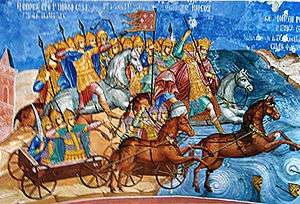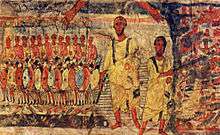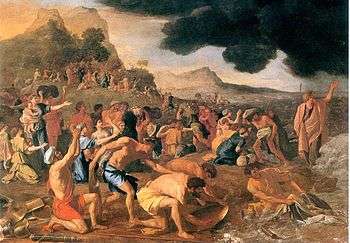Crossing the Red Sea
The Crossing of the Red Sea (Hebrew: קריעת ים סוף Kriat Yam Suph - Crossing of the Red Sea or Sea of Reeds ) is part of the biblical narrative of the escape of the Israelites, led by Moses, from the pursuing Egyptians in the Book of Exodus 13:17-14:29. This story is also mentioned in the Qur'an in Surah 26: Al-Shu'ara' (The Poets) in verses 60-67.[1]
According to the Exodus account, Moses held out his staff and the Red Sea was parted by God. The Israelites walked on the exposed ground and crossed the sea, followed by the Egyptian army. Moses again moved his staff once the Israelites had crossed and the sea closed again, drowning the whole Egyptian army.
Biblical narrative
God chooses Moses to lead the Israelites out of slavery in Egypt and into the land of Canaan, which God has promised to them. The Egyptian pharaoh, who previously said the opposite, agrees to let them go, and they travel from Ramesses to Succoth and then to Etham on the edge of the desert, led by a pillar of cloud by day and a pillar of fire by night. There God tells Moses to turn back and camp by the sea at Pi-hahiroth, between Migdol and the sea, directly opposite Baal-zephon.

God causes the pharaoh to pursue the Israelites with chariots, and he overtakes them at Pi-hahiroth. When the Israelites see the Egyptian army they are afraid, but the pillar of fire and the cloud separates the Israelites and the Egyptians. At God's command Moses holds his staff out over the water, and throughout the night a strong east wind divides the sea,[2] and the Israelites pass through with a wall of water on either side. The Egyptians pursue, but at daybreak God clogs their chariot-wheels and throws them into a panic, and with the return of the water the pharaoh and his entire army are destroyed (see Psalm 136:15). When the Israelites see the power of God they put their faith in God and in Moses, and sing a song of praise to the Lord for the crossing of the sea and the destruction of their enemies. (This song, at Exodus 15, is called the Song of the Sea).
The narrative contains at least three and possibly four layers. In the first layer (the oldest), God blows the sea back with a strong east wind, allowing the Israelites to cross on dry land; in the second, Moses stretches out his hand and the waters part in two walls; in the third, God clogs the chariot wheels of the Egyptians and they flee (in this version the Egyptians do not even enter the water); and in the fourth, the Song of the Sea, God casts the Egyptians into tehomat, the mythical abyss.[3]
Location of the crossing

The Israelites' first journey is from Ramesses to Succoth. Ramesses is generally identified with modern Qantir, the site of the 19th dynasty capital Per-Ramesses, and Succoth with Tell el-Maskhuta in Wadi Tumilat, the biblical Land of Goshen.[4] From Sukkoth the Israelites travel to Etham "on the edge of the desert," then turn back to Pi-hahiroth, located between Migdol and the sea and directly opposite Baal Zephon. None of these have been identified with certainty. One theory with a wide following is that they refer collectively to the region of Lake Timsah, a salt lake north of the Gulf of Suez, and the nearest large body of water after Wadi Tumilat.[5] Lake Timsah was connected to Pithom in Gesem at various times by a canal, and a late 1st millennium text refers to Migdol Baal Zephon as a fort on the canal.[6]
The Hebrew term for the place of the crossing is "Yam Suph". Although this has traditionally been thought to refer to the salt water inlet located between Africa and the Arabian peninsula, known in English as the Red Sea, this is a mistranslation from the Greek Septuagint, and Hebrew suph never means "red" but rather "reeds".[7] (While it is not relevant to the identification of the body of water, suph also puns on the Hebrew suphah ("storm") and soph ("end"), referring to the events of the Exodus).[8]
General scholarly opinion is that the Exodus story combines a number of traditions, one of them at the "Reed Sea" (Lake Timsah, with the Egyptians defeated when the wheels of their chariots become clogged) and another at the far deeper Red Sea, allowing the more dramatic telling of events.[6]
Reeds tolerant of salt water flourish in the shallow string of lakes extending from Suez north to the Mediterranean Sea. Kenneth Kitchen and James Hoffmeier state that these reedy lakes and marshes along the isthmus of Suez are acceptable locations for yam suf.[9][10] The ancient yam suf is not confined to the modern Red Sea. Hoffmeier equates yam suf with the Egyptian term pa-tjufy (also written p3 twfy) from the Ramsside period, which refers to lakes in the eastern Nile delta.[11] He also describes references to p3 twfy in the context of the Island of Amun, thought to be modern Tell el-Balamun.[12] Tell el-Balamun was the most northerly city of Pharaonic Egypt about 29 km southwest of Damietta, located at 31.2586 North, 31.5714 East.[13][14]
Historicity
No archaeological evidence has been found that confirms that the crossing of the Red Sea ever took place. Zahi Hawass, an Egyptian archaeologist and formerly Egypt's Minister of State for Antiquities Affairs, said of the Exodus and Passover story, the Israelite's’ biblical flight from Egypt and the 40 years of wandering the desert in search of the Promised Land:
Really, it’s a myth... Sometimes as archaeologists we have to say that never happened because there is no historical evidence.[15]
However, several scholars have asserted that a collective memory of the expulsion of the Hyksos may have formed the basis for the Israelite tradition of the Exodus.[16][17][18]
Legacy
The theme of Moses crossing the Red Sea was taken up by the panegyrists of Constantine the Great and applied to the battle of the Milvian Bridge (312). The theme enjoyed a vogue during the fourth century on carved sarcophagi: at least twenty-nine have survived in full or in fragments.[19] Eusebius of Caesarea cast Maxentius, drowned in the Tiber, in the role of Pharaoh, both in his Ecclesiastical History and in his eulogistic Life of Constantine.[20]
See also
- The Crossing of the Red Sea (Sistine Chapel)
- Crossing of the Red Sea (Bronzino)
- Moses in Islam
- Mount Sinai
- Plagues of Egypt
References
- ↑ "Quran". Retrieved 27 October 2016.
- ↑ Computer simulation of how a strong east wind could have parted the waters, BBC, 21 September 2010.
- ↑ Alberto Soggin, "An Introduction to the History of Israel and Judah", SCM Press, 1999, pp.136-7
- ↑ John Van Seters, "The Geography of the Exodus," in Silberman, Neil Ash (editor), The Land That I Will Show You: Essays in History and Archaeology of the Ancient Near East in Honor of J. Maxwell Miller (Sheffield Academic Press, 1997) p.270 ISBN 978-1850756507
- ↑ John Van Seters, "The Geography of the Exodus," in Silberman, Neil Ash (editor), The Land That I Will Show You: Essays in History and Archaeology of the Ancient Near East in Honor of J. Maxwell Miller (Sheffield Academic Press, 1997) P. 273 ISBN 978-1850756507
- 1 2 Gmirkin, Russell (15 May 2006). "Berossus and Genesis, Manetho and Exodus: Hellenistic Histories and the Date of the Pentateuch". Bloomsbury Publishing USA. Retrieved 27 October 2016 – via Google Books.
- ↑ Kenneth Kitchen, "On the Reliability of the Old Testament" (Eerdman's, 2003), pp.261-263
- ↑ Hoffmeier, James Karl (1999). Israel in Egypt: The Evidence for the Authenticity of the Exodus Tradition. Oxford: Oxford University Press. p. 214. ISBN 978-0-19-513088-1. OCLC 47007891.
- ↑ Kenneth Kitchen (2003), On the Reliability of the Old Testament, pp. 261-263.
- ↑ James Hoffmeier (2005), Ancient Israel in Sinai: The Evidence for the Authenticity of the Wilderness Tradition, pp. 81-85.
- ↑ James Hoffmeier (2008) The Archaeology of the Bible, p. 54
- ↑ James Hoffmeier (2005), Ancient Israel in Sinai: The Evidence for the Authenticity of the Wilderness Tradition, p. 86.
- ↑ AJ Spencer (2009), Excavations at Tell el-Balamun 2003-2008, British Museum.
- ↑ "Tell el-Balamun: A City of the Nile Delta of Egypt". The British Museum. Retrieved 22 October 2012.
- ↑ "Did the Red Sea Part? No Evidence, Archaeologists Say". The New York Times. 3 April 2007. Retrieved 27 October 2016.
- ↑ Oblath 2004, p. 21.
- ↑ Droge 1996, p. 134.
- ↑ Israel Finkelstein and Neil Asher Silberman, Free Press, New York, 2001, 385 p. 68-69, ISBN 0-684-86912-8
- ↑ Paul Stephenson, Constantine, Roman Emperor, Christian victor, 2010:209f.
- ↑ Eusebius, HE ix.9, Vita Constantini i.38.
| Previous Station: Pi-hahiroth |
The Exodus Stations list |
Next Station: Marah |
External links
| Wikimedia Commons has media related to Crossing of Red Sea. |
- ABZU
- ARCHNet Near East Resources List
- Fitzwilliam Museum Egyptology Resources
- Theban Mapping Project
- A collection of articles on the splitting of the Red Sea from a Jewish viewpoint
